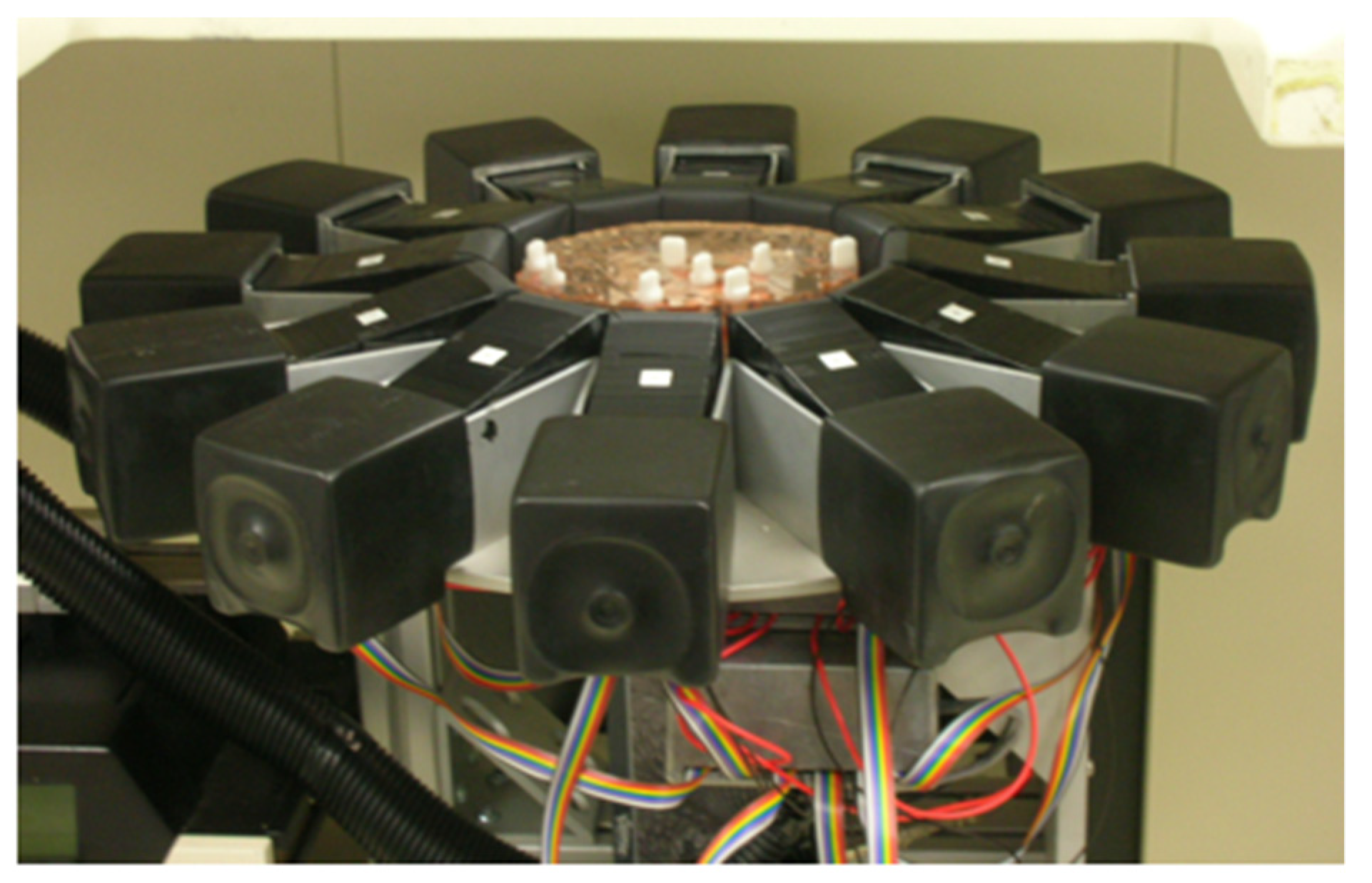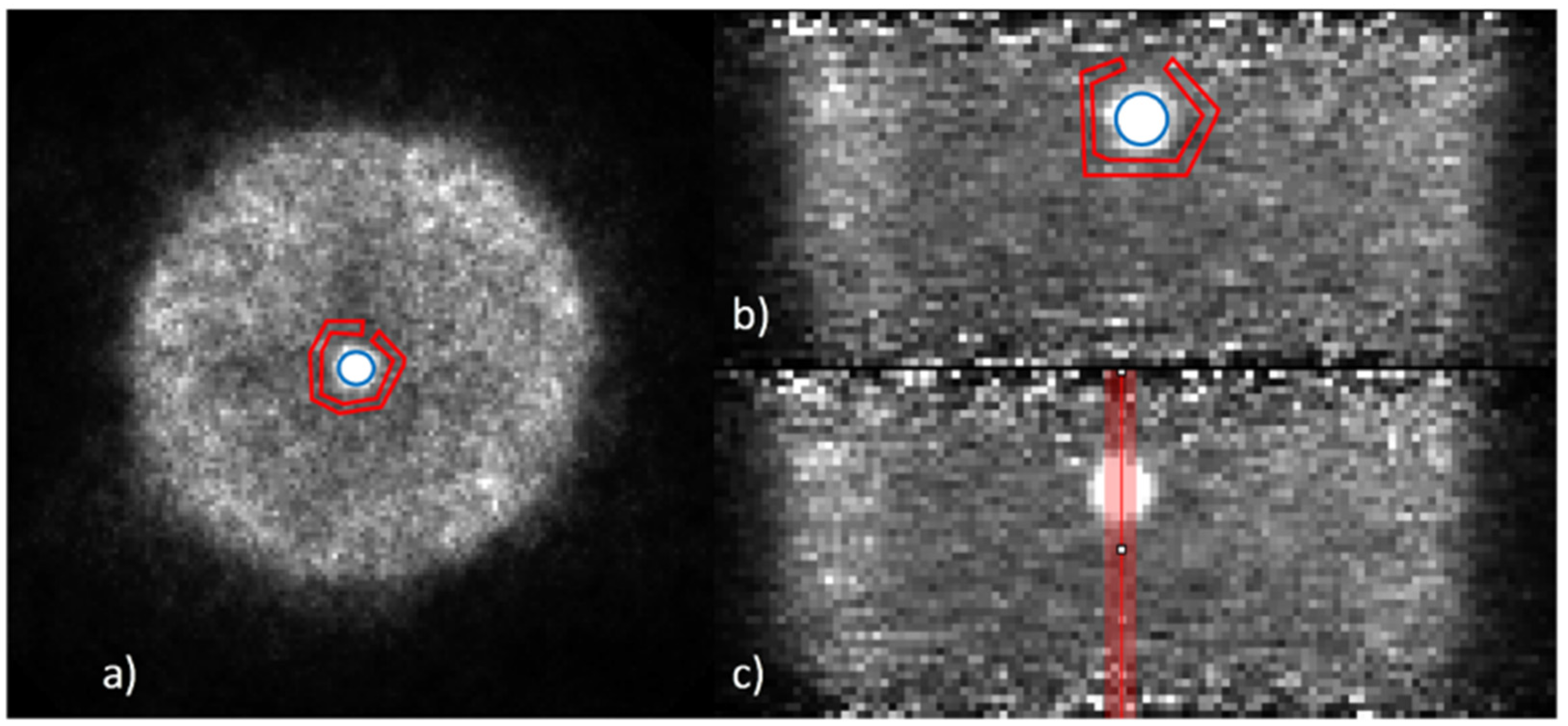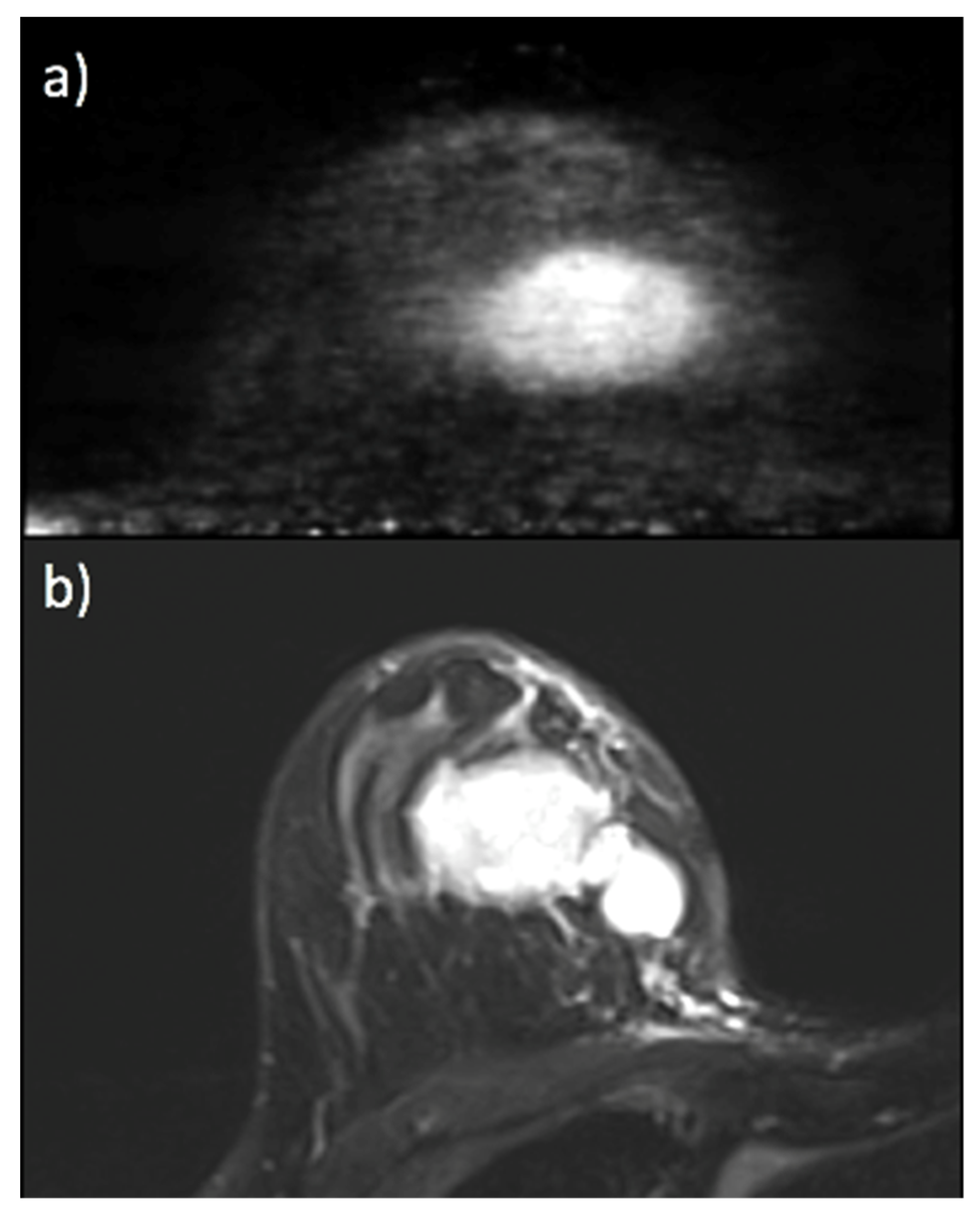Characterization and Pilot Human Trial of Dedicated Breast Ring Positron Emission Tomography (BRPET) System
Abstract
1. Introduction
2. Materials and Methods
2.1. Scanner Design
2.2. Imaging Performance
2.3. Energy Resolution
2.4. Spatial Resolution
2.5. System Sensitivity
2.6. Count Rate and Scatter Fraction
2.7. Vertical Extent of VoV and Image Quality for Posterior Tissue Imaging
2.8. Pilot Human Study
3. Results
3.1. Energy Resolution
3.2. Spatial Resolution
3.3. System Sensitivity
3.4. Count Rate and Scatter Fraction
3.5. Image Quality for Posterior Tissue Imaging
3.6. Pilot Human Study
4. Discussion
5. Conclusions
Author Contributions
Funding
Institutional Review Board Statement
Informed Consent Statement
Data Availability Statement
Conflicts of Interest
References
- Paydary, K.; Seraj, S.M.; Zadeh, M.Z.; Emamzadehfard, S.; Shamchi, S.P.; Gholami, S.; Werner, T.J.; Alavi, A. The Evolving Role of FDG-PET/CT in the Diagnosis, Staging, and Treatment of Breast Cancer. Mol. Imaging Biol. 2019, 21, 1–10. [Google Scholar] [CrossRef] [PubMed]
- Wu, D.; Gambhir, S.S. Positron Emission Tomography in Diagnosis and Management of Invasive Breast Cancer: Current Status and Future Perspectives. Clin. Breast Cancer 2003, 4 (Suppl. 1), S55–S63. [Google Scholar] [CrossRef] [PubMed]
- Avril, N.; Adler, L.P. F-18 Fluorodeoxyglucose-Positron Emission Tomography Imaging for Primary Breast Cancer and Loco-Regional Staging. Radiol. Clin. N. Am. 2007, 45, 645–657. [Google Scholar] [CrossRef] [PubMed]
- Weinberg, I.; Majewski, S.; Weisenberger, A.; Markowitz, A.; Aloj, L.; Majewski, L.; Danforth, D.; Mulshine, J.; Cowan, K.; Zujewski, J.; et al. Preliminary results for positron emission mammography: Real-time functional breast imaging in a conventional mammography gantry. Eur. J. Nucl. Med. 1996, 23, 804–806. [Google Scholar] [CrossRef] [PubMed]
- MacDonald, L.; Edwards, J.; Lewellen, T.; Haseley, D.; Rogers, J.; Kinahan, P. Clinical Imaging Characteristics of the Positron Emission Mammography Camera: PEM Flex Solo II. J. Nucl. Med. 2009, 50, 1666–1675. [Google Scholar] [CrossRef] [PubMed]
- Kalinyak, J.E.; Berg, W.A.; Schilling, K.; Madsen, K.S.; Narayanan, D.; Tartar, M. Breast cancer detection using high-resolution breast PET compared to whole-body PET or PET/CT. Eur. J. Nucl. Med. Mol. Imaging 2014, 41, 260–275. [Google Scholar] [CrossRef] [PubMed]
- Eo, J.S.; Chun, I.K.; Paeng, J.C.; Kang, K.W.; Lee, S.M.; Han, W.; Noh, D.-Y.; Chung, J.-K.; Lee, D.S. Imaging sensitivity of dedicated positron emission mammography in relation to tumor size. Breast 2012, 21, 66–71. [Google Scholar] [CrossRef] [PubMed]
- Wu, Y.; Bowen, S.L.; Yang, K.; Packard, N.; Fu, L.; Burkett, G.; Qi, J.; Boone, J.M.; Cherry, S.R.; Badawi, R.D. PET characteristics of a dedicated breast PET/CT scanner prototype. Phys. Med. Biol. 2009, 54, 4273. [Google Scholar] [CrossRef] [PubMed]
- Raylman, R.R.; Majewski, S.; Smith, M.F.; Proffitt, J.; Hammond, W.; Srinivasan, A.; McKisson, J.; Popov, V.; Weisenberger, A.; Judy, C.O.; et al. The positron emission mammography/tomography breast imaging and biopsy system (PEM/PET): Design, construction and phantom-based measurements. Phys. Med. Biol. 2008, 53, 637–653. [Google Scholar] [CrossRef] [PubMed]
- Kitamura, K.; Ohi, J.; Tonami, H.; Yamada, Y.; Furumiya, T.; Furuta, M.; Satoh, M.; Tsuda, T.; Nakazawa, M.; Hashizume, N.; et al. Development of a C-shaped breast PET scanner equipped with four-layer DOI detectors. In Proceedings of the 2008 IEEE Nuclear Science Symposium Conference Record, Dresden, Germany, 19–25 October 2008; pp. 5662–5665. [Google Scholar]
- Iima, M.; Nakamoto, Y.; Kanao, S.; Sugie, T.; Ueno, T.; Kawada, M.; Mikami, Y.; Toi, M.; Togashi, K. Clinical performance of 2 dedicated PET scanners for breast imaging: Initial evaluation. J. Nucl. Med. 2012, 53, 1534–1542. [Google Scholar] [CrossRef] [PubMed][Green Version]
- Moliner, L.; González, A.J.; Soriano, A.; Sánchez, F.; Correcher, C.; Orero, A.; Carles, M.; Vidal, L.F.; Barberá, J.; Caballero, L.; et al. Design and evaluation of the MAMMI dedicated breast PET. Med. Phys. 2012, 39, 5393–5404. [Google Scholar] [CrossRef] [PubMed]
- Miyake, K.K.; Matsumoto, K.; Inoue, M.; Nakamoto, Y.; Kanao, S.; Oishi, T.; Kawase, S.; Kitamura, K.; Yamakawa, Y.; Akazawa, A.; et al. Performance Evaluation of a New Dedicated Breast PET Scanner Using NEMA NU4-2008 Standards. J. Nucl. Med. 2014, 55, 1198–1203. [Google Scholar] [CrossRef] [PubMed]
- Masumoto, N.; Kadoya, T.; Fujiwara, M.; Murakami, C.; Yoshikawa, T.; Handa, Y.; Amioka, A.; Gohda, N.; Kono, M.; Sasada, S.; et al. Dedicated breast PET to improve clinical diagnosis of breast cancer: Initial evaluation. JCO 2017, 35, e12097. [Google Scholar] [CrossRef]
- Majewski, S. High Resolution PET Breast Imager with Improved Detection Efficiency. 2010. Available online: https://patents.google.com/patent/US7732774B2/en (accessed on 30 July 2018).
- Popov, V.; Majewski, S.; Weisenberger, A.G. Readout electronics for multianode photomultiplier tubes with pad matrix anode layout. In Proceedings of the 2003 IEEE Nuclear Science Symposium Conference Record (IEEE Cat No03CH37515), Portland, OR, USA, 19–25 October 2003; Volume 3, pp. 2156–2159. [Google Scholar]
- Smith, M.F.; Raylman, R.R. PEM-PET Image Reconstruction in a Clinically-Relevant Time Frame. In Proceedings of the 2006 IEEE Nuclear Science Symposium Conference Record, San Diego, CA, USA, 29 October–1 November 2006; pp. 1792–1796. [Google Scholar]
- International Commission on Radiation Units and Measurements. Tissue substitutes in radiation dosimetry and measurement. In ICRU Technical Report No. 44; ICRU: Bethesda, MD, USA, 1989. [Google Scholar]
- Performance Measurements of Small Animal Positron Emission Tomographs (PETs). Available online: https://www.nema.org/Standards/Pages/Performance-Measurements-of-Small-Animal-Positron-Emission-Tomographs.aspx (accessed on 13 January 2017).
- Queiroz, M.A.; Wollenweber, S.D.; von Schulthess, G.; Delso, G.; Veit-Haibach, P. Clinical image quality perception and its relation to NECR measurements in PET. EJNMMI Phys. 2014, 1, 1–13. Available online: https://www.ncbi.nlm.nih.gov/pmc/articles/PMC4546067/ (accessed on 28 May 2019).
- Avril, N.; Bense, S.; Ziegler, S.I.; Dose, J.; Weber, W.; Laubenbacher, C.; Römer, W.; Jänicke, F.; Schwaiger, M. Breast imaging with fluorine-18-FDG PET: Quantitative image analysis. J. Nucl. Med. 1997, 38, 1186–1191. [Google Scholar] [PubMed]
- Buck, A.; Schirrmeister, H.; Kühn, T.; Shen, C.; Kalker, T.; Kotzerke, J.; Dankerl, A.; Glatting, G.; Reske, S.; Mattfeldt, T. FDG uptake in breast cancer: Correlation with biological and clinical prognostic parameters. Eur. J. Nucl. Med. 2002, 29, 1317–1323. [Google Scholar] [CrossRef] [PubMed]
- ICRP. ICRP Publication 106. Available online: http://www.icrp.org/publication.asp?id=ICRP%20Publication%20106 (accessed on 22 July 2018).
- Luo, W.; Anashkin, E.; Matthews, C.G. Performance Evaluation of a PEM Scanner Using the NEMA NU 4 #x2014; 2008 Small Animal PET Standards. IEEE Trans. Nucl. Sci. 2010, 57, 94–103. [Google Scholar]
- Slomka, P.J.; Pan, T.; Germano, G. Recent Advances and Future Progress in PET Instrumentation. Semin. Nucl. Med. 2016, 46, 5–19. [Google Scholar] [CrossRef] [PubMed]
- Teixeira, S.C.; Rebolleda, J.F.; Koolen, B.B.; Wesseling, J.; Jurado, R.S.; Stokkel, M.P.M.; Santiago, M.D.P.C.; Van Der Noort, V.; Rutgers, E.J.T.; Olmos, R.A.V. Evaluation of a Hanging-Breast PET System for Primary Tumor Visualization in Patients With Stage I–III Breast Cancer: Comparison With Standard PET/CT. Am. J. Roentgenol. 2016, 206, 1307–1314. [Google Scholar] [CrossRef] [PubMed]
- Graña-López, L.; Herranz, M.; Domínguez-Prado, I.; Argibay, S.; Villares, A.; Ruibal, A.; Vázquez-Caruncho, M. Dedicated breast PET value to evaluate BI-RADS 4 breast lesions. Eur. J. Radiol. 2018, 108, 201–207. [Google Scholar] [CrossRef] [PubMed]
- O’Connor, M.K.; Tran, T.D.; Swanson, T.N.; Ellingson, L.R.; Hunt, K.N.; Whaley, D.H. Improved visualization of breast tissue on a dedicated breast PET system through ergonomic redesign of the imaging table. EJNMMI Res. 2017, 7, 1–9. Available online: https://www.ncbi.nlm.nih.gov/pmc/articles/PMC5736520/ (accessed on 24 November 2018). [CrossRef] [PubMed]








| Number of Adjacent Detectors, i | Timing Window (ns) | Peak NEC Rate (kcps) |
|---|---|---|
| 1 | 8 | 2.77 (16 MBq) |
| 10 | 3.87 (19 MBq) | |
| 12 | 4.28 (18 MBq) | |
| 2 | 8 | 4.11 (18 MBq) |
| 10 | 4.69 (20 MBq) | |
| 12 | 5.33 (21 MBq) | |
| 3 | 8 | 1.56 (18 MBq) |
| Lesion Diameter (cm) | Lesion Concentration (kBq/mL) | Background Concentration (μCi/mL) | LBR * |
|---|---|---|---|
| 1.2 | 113.2 | 38.1 | 3.1 |
| 1.2 | 75.5 | 37.7 | 2.1 |
| 0.8 | 129.5 | 41.8 | 3.1 |
| 0.8 | 80.3 | 38.1 | 2.1 |
| Sequence Name | Number of Scans | Voxel Size (mm3) | Slice Thickness (mm) | TR (ms) | TE 1 (ms) | TE 2 (ms) | Flip Angle (degrees) | Gadolinium Contrast Injection |
|---|---|---|---|---|---|---|---|---|
| Axial T2 FS Dixon | 1 | 0.8 × 0.8 × 3.0 | 3 | 5630 | 81 | N/A | 165 | pre |
| Axial T1 3D | 1 | 0.8 × 0.8 × 1.3 | 1.3 | 6.03 | 2.57 | N/A | 20 | pre |
| Axial 3D T1 Dixon Dynamic | 4 | 0.8 × 0.8 × 1.3 | 1.3 | 5.67 | 2.46 | 3.69 | 14 | 1 pre/3 post |
| Axial 3D T1 Dixon High Resolution | 1 | 0.9 × 0.9 × 0.8 | 0.8 | 5.67 | 2.46 | 3.69 | 14 | post |
| Tumor Status and Type | Number of Lesions |
|---|---|
| Benign | |
| Lobular Carcinoma in situ | 1 |
| Fibroadenoma | 1 |
| Stromal Fibrosis | 1 |
| Fat Necrosis | 1 |
| Malignant | |
| Infiltrating Ductal Carcinoma | 5 |
| Infiltrating Lobular Carcinoma | 2 |
| Modality | BRPET | CE-MRI | BRPET | CE-MRI | ||
|---|---|---|---|---|---|---|
| Reader | NM 1 | NM 2 | BR | NM 1 | NM 2 | BR |
| Suspicion score ≥3 is positive | Suspicion score ≥4 is positive | |||||
| Sensitivity (%) | 100 | 100 | 100 | 85.7 | 100 | 100 |
| Specificity (%) | 100 | 100 | 25 | 100 | 100 | 25 |
| PPV (%) | 100 | 100 | 70 | 100 | 100 | 70 |
| Accuracy (%) | 100 | 100 | 72.7 | 90.9 | 100 | 72.7 |
| Author | System | Axial Resolution (mm) | Transaxial Resolution (mm) | Total Sensitivity (%) | Maximum NECR (kcps) |
|---|---|---|---|---|---|
| This work | BRPET | 1.8 | 1.9 | 0.97 (460–562 keV) | 5.33 (21 MBq) |
| Luo et al. (ref. [24]) | Naviscan | 6.2 | 1.8 | 18 (350–700 keV) | 10.6 (25 MBq) |
| Wu et al. (ref. [9]) | 2-camera PET | 2.17 | 2.7 | 1.64 (350–650 keV) | 19.3 (11.8 MBq) |
| Moliner et al. (ref. [13]) | MAMMI PET | 1.6 | 1.9 | 20 (250–750 keV) | 25 (44 MBq) |
| Miyake et al. (ref. [14]) | Shimadzu Full-Ring PET | 1 | 0.7 | 16.3 (100–800 keV) | 300 (44 MBq) |
Publisher’s Note: MDPI stays neutral with regard to jurisdictional claims in published maps and institutional affiliations. |
© 2021 by the authors. Licensee MDPI, Basel, Switzerland. This article is an open access article distributed under the terms and conditions of the Creative Commons Attribution (CC BY) license (https://creativecommons.org/licenses/by/4.0/).
Share and Cite
Polemi, A.M.; Kogler, A.K.; Rehm, P.K.; Lancaster, L.; Peppard, H.R.; Dillon, P.M.; Stolin, A.V.; Majewski, S.; Williams, M.B. Characterization and Pilot Human Trial of Dedicated Breast Ring Positron Emission Tomography (BRPET) System. Instruments 2021, 5, 30. https://doi.org/10.3390/instruments5030030
Polemi AM, Kogler AK, Rehm PK, Lancaster L, Peppard HR, Dillon PM, Stolin AV, Majewski S, Williams MB. Characterization and Pilot Human Trial of Dedicated Breast Ring Positron Emission Tomography (BRPET) System. Instruments. 2021; 5(3):30. https://doi.org/10.3390/instruments5030030
Chicago/Turabian StylePolemi, Andrew M., Annie K. Kogler, Patrice K. Rehm, Luke Lancaster, Heather R. Peppard, Patrick M. Dillon, Alexander V. Stolin, Stanislaw Majewski, and Mark B. Williams. 2021. "Characterization and Pilot Human Trial of Dedicated Breast Ring Positron Emission Tomography (BRPET) System" Instruments 5, no. 3: 30. https://doi.org/10.3390/instruments5030030
APA StylePolemi, A. M., Kogler, A. K., Rehm, P. K., Lancaster, L., Peppard, H. R., Dillon, P. M., Stolin, A. V., Majewski, S., & Williams, M. B. (2021). Characterization and Pilot Human Trial of Dedicated Breast Ring Positron Emission Tomography (BRPET) System. Instruments, 5(3), 30. https://doi.org/10.3390/instruments5030030






